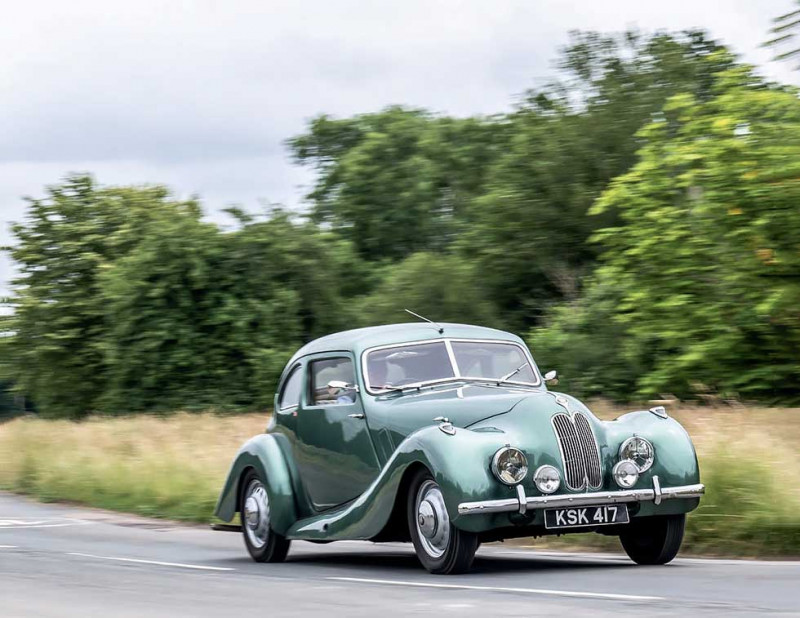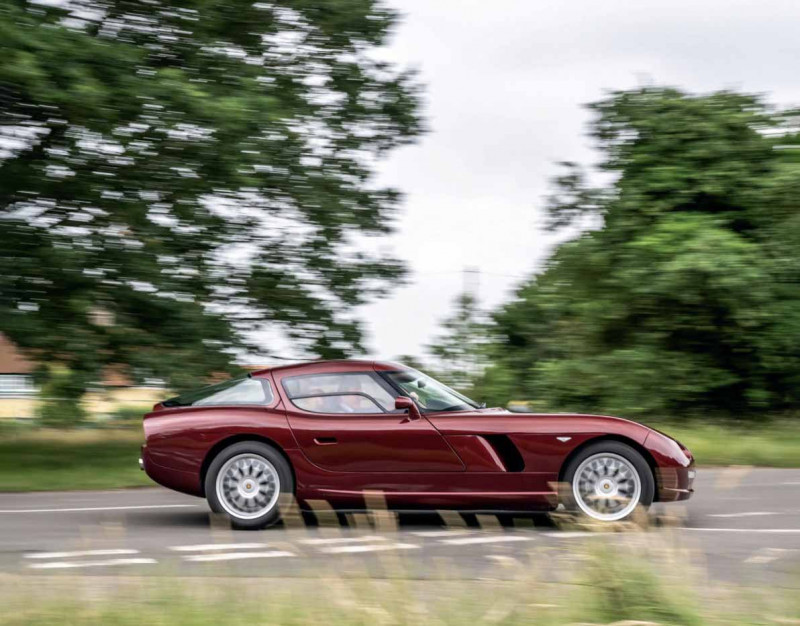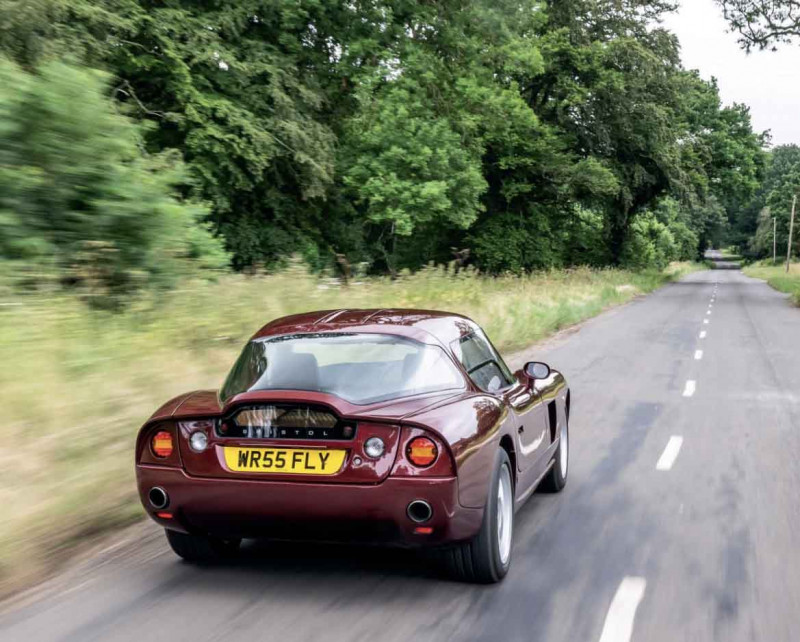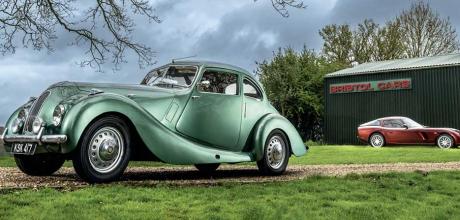1947 Bristol 400 vs. 2005 Bristol Fighter
One Bristol enthusiast liked the company so much he bought the famous Kensington showroom frontage – plus examples of its first and last cars. Robert Coucher drives the 400 and Fighter.
Photography Barry Hayden
SIGN OF THE TIMES
FIRST AND LAST BRISTOLS
Early 400 and last-of-line Fighter driven
In the early 1990s, I lived in Portsmouth and used to commute up to London with a chum on a regular basis,’ says Bristol enthusiast Neil Clifford.

‘Naturally we’d get stuck in traffic, often in Kensington, so I’d pull over and we’d go and gaze through the glass and into the Bristol Showroom on the corner of Kensington High Street, number 370. And yes, that’s the same “Bristol Cars” sign you see on my car hangar that used to adorn the showroom frontage, but I’ll come to that…
‘The proprietor, Anthony Crook – I always enjoyed his name badge “A Crook” – knew we were just a bunch of young lads with no money, but he started to invite us in and show us around the cars. He’d tell us about his time as a Spitfire pilot, as well as racing with Stirling Moss back in the 1950s. A real gentleman. I kept telling him that one day I’d come in and buy a Bristol.’

Neil smiles. ‘Having been car mad since a child, I devoured all the car magazines and really enjoyed LJK Setright and his fascination with Bristols. The way he wrote about them intrigued me.’
Here’s an example: ‘The idea has always been to produce a car of exceptional equilibrium. Unquestionably a driver’s car (itself a matter of balance), it must inspire the faith of its passengers; a gentleman’s car, it must not offend those who are not gentlemen; a seriously fast car, it must be intrinsically safe; an engineer’s car, it must not be wanting in art and the refinement of luxury. In all its qualities it must be an exercise in complementaries, not in compromises.’
Neil continues: ‘By 2008 my business was doing well and I had some money, so I went into the showroom and told Tony that I’d finally arrived to actually buy a car. He sold me a turbocharged Brigand, painted Air Force Blue. I loved the car and owned it for seven years. It looked like a big Austin and no-one really knew what it was or how fast it was. That great big single turbo took a moment to spool up… then wallop!’

BEFORE WORLD WAR TWO, Frazer Nash motor cars were the preferred choice of sporting young men who wanted to go racing. Frazer Nash went bust in 1927 and was taken over by AFN Ltd, run by Harold Aldington, who was also the UK agent for BMW, selling the excellent 328 of the time as a Frazer Nash BMW. Aldington was also a director of the Bristol Aeroplane Company, which had designs on building a motor car.
The company thought it prudent not to build a car from scratch, and Aldington, who knew how good the BMW 326, 327 and 328 models were, used his Army contacts to visit the bombed BMW factory in Munich in 1945 and came back with ‘war reparations’ in the form of all the manufacturing plans and specifications for the BMWs, along with its chief engineer, Dr Fritz Fiedler, who was obviously keen on the prospect of life in England rather than in the Soviet-controlled sector of Germany. Bristol Cars was started in 1945 as a subsidiary of BAC. Its first car was unveiled at the Geneva motor show in 1947. The 400 was not ostensibly a sports car: it was a quality four-seater, meticulously assembled so as to appeal to drivers with a ‘sporting inclination’. Derived almost entirely from the pre-war BMWs, it featured a chassis based on the 326’s, the engine on the 328’s and the bodywork on the 327’s. What Bristol brought to the party was advanced aeronautical engineering skills.

While the BMW designs were superb, some of the materials they were forced to employ prior to the war were not good (Germany’s growing military got first dibs) and metallurgy was a Bristol strong point. This first Bristol, the 400, proved to be the company’s most successful car in motorsport and competition, which included winning the Polish International Rally in 1948 and finishing third in the Monte Carlo Rally a few months later. In 1948 a 400 finished second in the over-1100cc class and third overall in the Mille Miglia, driven by Count Johnny Lurani and HJ Aldington. Not bad for a ‘four-seater’.
‘I bought the 400 a couple of years ago and, as it is the first Bristol, it makes a nice bookend to the Fighter, which is the last car Bristol built,’ says Neil. ‘My intention was to take part in the Mille Miglia with my daughter, who has inherited my love of old cars, but with Covid and all that things were put on hold. It has a number of Series Two improvements, which are very useful for rallying, including a heater, opening rear window for ventilation, and the spare mounted on the boot. Ironically it is the only 400 fitted with wind-up windows, whereas the last Bristol Fighter does with small sentry-box windows; Neil points out.

Painted in its original Jade Green shade, the 400 has a continuous documented history from new, indicating 14 owners in its 75-year life, during which it has covered 300,000 miles. It was first registered to the Bristol Aeroplane Company and used by its Chief Test Pilot, Cyril Unwin, as his company car. More recently comprehensively rebuilt by specialist Spencer Lane Jones, KSK 417 has been lightly tweaked for rallying but retains its original engine, in this guise fitted with triple Solex carburettors, and has a later gearbox that features an overdrive. Seatbelts, an electric fan, better lights and rally clocks render it fit for purpose as a driver's car, so let's see how it responds to a good dose of Octane.
The 'first' Bristol is an attractive coupe but nowhere as low-slung and svelte as the original Autenreith 327, being more British in appearance. A bit frumpier. Open the suicide door and the interior is narrow with a low seating position. The seats are chairs and the dashboard is trad wood veneer with Smiths instruments scattered about, plus the modem rally-timers, and the rev-counter's red paint starts at a lowly 4250rpm.
The steering wheel is a large, springy three-spoked affair that you reach around to pull on the choke and manual throttle lugs, then turn the key, give the throttle pedal a jab and thumb the starter button. The 2.0-litre straight-six, with its ingenious cross-pushrod design, fires up sounding vocal and keen. Give it half a minute or so to get the juices flowing, then depress the choke and throttle buttons and let it settle.
First thing you notice is how smooth and isolated the engine feels; there's no throb coming into the cabin as it runs so sweetly. The clutch is surprisingly light but very short of throw and the gear-lever selects first without resistance. The triple Solexes allow for a very reactive throttle pedal and within even the first few yards you can feel how light and nimble this 1117kg car will be. Out onto narrow country lanes the 400 is in its element. It's small and narrow, the torsion bar suspension soaks up broken tarmac with aplomb, the engine feels as though it’s mustering more than its original 85bhp and the later gearbox is a delight.
Count Lurani enjoyed racing the 400 on the Mille Miglia but complained about the awful drum brakes. These drums have clearly been improved and are more than a match for the 5.50 R16 Michelin tyres’ grip as the fronts lock up more than once. Swinging out onto the fast A41 dual carriageway, it’s time to give the 400 a proper run. The engine is eager to rev to around 5500rpm, then change up and allow the longer overdrive gearing to run on the torque. The rack-and-pinion steering is accurate, the aerodynamic coachwork cleaves the air, the suspension quells any unruliness and the straight-six sings in perfect balance. Glance at the speedometer and you realise you are travelling a lot faster than you thought. This is one of those lightweight, balanced, focused motor cars that is better on the road than you’d imagine because everything has been weighted-up to work in harmony. With growing confidence, it is rewarding to slew the Bristol into roundabouts on its skinny tyres and feel it point exactly where you want it before that super 328 engine rasps you out onto the straight with just enough grunt to make you smile. It feels so much more than the sum of its parts, even though Bristol raided the BMW parts bin so cleverly. To my mind this is a British interpretation of that other delicate Mille Miglia giantkiller, the Lancia Aurelia B20GT.
And the big beast lurking in the background? It’s a Fighter, one of only nine thought to have been constructed and a real outlier. Singular looks, gullwing doors, the 8.0-litre Viper V10 engine, 210mph claimed top speed and enough cabin room that you can wear a hat.
‘There’s no logic to the Fighter but I love it,’ laughs Neil. ‘I’ve owned it for 11 years and it’s done 23,000 miles, probably the highest of any Fighter. The previous owner used it as his daily driver, so it had issues, especially with overheating and the cabin getting really hot, but I have had the floors covered in Dynamat, which helps. The suspension has been rebuilt, along with the brakes and exhaust, and now it behaves and is really fast.’
The Fighter was billed as a supercar when launched in 2004. Bristol stalwarts (of which there were but a few) were horrified at the car’s sporty overtness, instilled by the then-new Bristol boss Toby Silverton in a bid to save the company. Designed by Brabham F1 engineer Max Boxstrom, the narrow coupé has a drag factor of just 0.28 and an ample 525bhp to haul it along. It weighs-in at under 1600kg, which is light by supercar standards so it accelerates to 60mph in four seconds.
Entry is easy though the vast gullwing door. Th e seat is large and comfortable and mounted high so you don’t have to climb down into the cabin. Th e steering wheel recalls those of earlier Bristols and the chunky gear-lever is angled towards you. Instruments are the usual, with added ‘engine hours’ meter and other aircraft allusions. Twist the key and the massive V10 fires with a deep resonance. Th e clutch goes down easily and the gear-lever moves co-operatively. Th e Fighter eases off thanks to 350lb ft from idle, allowing you to get comfortable and change up through the gears. In Bristol fashion this supercar is narrow so, again, it’s happy on tight B-roads. Th e driving position is commanding, outward vision good, while the chassis offers accurate, balanced responses, helped by sharp steering and vented brakes.
The Fighter remains totally laid-back and obedient on country roads but it really switches on along a fast dual carriageway. Th e power of its Dodge Viper-sourced 7990cc engine is industrial – it charges instantaneously without losing its cool or seeming to be trying at all. Th is is an old-fashioned engine and glorious in a way that’s no longer available in something new. Most performance cars now suffer small-displacement turbocharged, electronically managed units, which will never deliver the thump of a lump like this.
Being the first and last Bristol models built, these two should remain as a pair. And there is no ‘winner’ here. What I’d suggest to Neil Clifford is that he drives the Fighter down to Brescia, then enjoys the Mille Miglia retrospective with his daughter in the 400. Perfect plan.
Oh, and the sign? Neil explains: ‘Th e Bristol Cars liquidation auction was held in August 2020 so I went along and couldn’t help bidding for the showroom sign. It was damaged and looked a mess but I won the bid. It has been beautifully restored, which naturally cost a lot more than the purchase price. It’s the iconic sign I remember fondly and I am so pleased to now have it on my car hangar. I even had it wired so it can be illuminated as it often was in the day – “BISTO ARS”!’
Clockwise from above Incredible scenery is a given – and how about that sky for December Lamborghini test driver Valentino Balnboni was amon Aditaquae pari iuntion sequae as moluptas.
This page and opposite Quite literally the ultimate Bristol, it’s reckoned only nine Fighters were built, with an 8.0-litre Viper V10, gullwing doors, singular styling and a typically individual interior.
TECHNICAL DATA 2005 Bristol Fighter
- Engine 7990cc OHV V10, fuel injection
- Max Power 525bhp @ 5500rpm
- Transmission Six-speed manual, rear-wheel drive
- Steering Rack and pinion, power-assisted
- Suspension Front and rear: double wishbones, coil springs, telescopic dampers. Front anti-roll bar
- Brakes Vented discs
- Weight 1580kg
- Top speed 210mph (claimed)
TECHNICAL DATA 1947 Bristol 400
- Engine 1971cc OHV straight-six, cross pushrods, triple Solex carburettors
- Max Power 85bhp @ 4200rpm
- Transmission Four-speed manual with overdrive, rear-wheel drive
- Steering Rack and pinion
- Suspension Front: wishbones, transverse leaf spring, telescopic dampers. Rear: live axle, torsion bars,
- lever-arm dampers
- Brakes Drums
- Weight 1117kg
- Top speed 94mph
Clockwise, from above Classic Halda Twinmaster reveals rally use; characterful and cosy interior; BMW-based 2.0-litre six is charismatic; handling is assured.
Above and opposite Spoils of World War Two meant a superb kit of parts for Bristol to play with, including engine, chassis and body all based on BMW designs.
‘The 400 was meticulously assembled so as to appeal to drivers with a sporting inclination’


